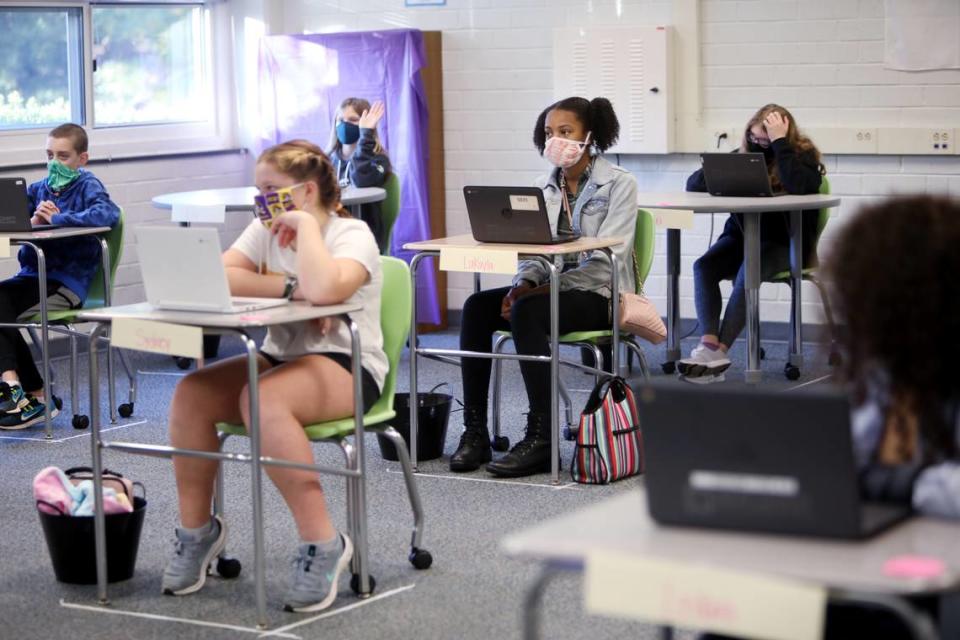A Raleigh middle school ditched its letter grades. Should other Wake schools join?
Students at a Raleigh middle school have embraced the elimination of traditional A through F letter grades.
But their parents aren’t as supportive of the change.
Since 2018, teachers at Carroll Middle School in Raleigh have rated how well their students are doing at meeting individual standards instead of giving letter grades. It’s supposed to help parents and students show where they’re on pace and where they’re behind in different areas.
“Student and teacher satisfaction with the grading system improved through the pilot,” Colleen Paeplow, Wake County’s senior director for program accountability, data, research and accountability, told the school board on Monday. “However, the parents are still unsure about how to interpret these grades.”
On Monday, Wake County school administrators recommended continuing the “competency -based grading” program at Carroll.

If other middle schools want to join, administrators recommended phasing the change in one grade level at a time. But several school board members suggested getting more data at Carroll before expanding the pilot.
Under state law, the school board would have to approve any switch away from traditional letter grades. No other middle schools have yet said they want to join the pilot, according to Eric Fitts, senior director for middle school programs.
“We have to be sure that it’s done really very well before we go further with this,” said board member Roxie Cash.
‘Carroll is the leader’
Wake moved away from A-F grading in elementary schools in 2004, switching to a system where report cards are based on grades of Level 1 to Level 4.
When Wake students move to middle school, they get report cards with a numerical grade for each subject. The numerical grades are based on a 10-point scale where, for instance, an A is 90 to 100 and a B is 80 to 89.
Wake’s high schools are required to use the A-F grades to comply with state law on what’s recorded on high school transcripts.
In 2018, the school board gave permission for Carroll Middle, a magnet school near North Hills in Raleigh, to try the new grading initiative.
“It’s exciting that Carroll is the leader in this, and it’s also I’m sure very unnerving because Carroll is the leader in this in being the only middle school that has moved to standards-based grading,” said board member Christine Kushner.
Leaders at Carroll made the change, in part, due to lower-than-expected student test results.
The pandemic has made it more difficult to assess how the program has gone at Carroll. For instance, the grading system has been revised multiple times since the pilot started.
But researchers say the program didn’t appear to have any negative impact on Carroll students when they entered Sanderson High School and returned to traditional grades.
In the 2020-21 school year, graduates of Carroll had similar grade point averages at Sanderson compared to other students. For instance, the 10th-grade GPA of the Carroll graduates was 2.6 compared to 2.5 for other Sanderson sophomores.
Students support new grading system
Wake used surveys to see how students, teachers and parents at Carroll thought about the new grading system.
The most favorable survey results came from students, where the percentage who felt their grades do a good job of measuring what they are able to do rose from 46.6% in the 2018-19 school year to 78.4% in the 2020-21 school year.
Wake didn’t get enough survey responses from Carroll teachers in the 2020-21 school year to report results.
But the percentage of teachers who reported satisfaction with the grading system at Carroll rose from 21.6% in the 2018-19 school year to 41.3% in the 2019-20 school year. A similar gain happened when the percentage of teachers who believed that student report cards accurately reflected what they’re learning rose from 23.5% to 52.2%.
“With COVID, staff turnover and the lack of training, It was a challenge for teachers to do something different from what they knew,” said Tina Zarecki, Carroll’s principal.
‘Makes no sense’
The percentage of Carroll parents who felt the school’s grading system fairly evaluated students dropped after the new system was used. It went from 57% who felt it was fair in the 2017-18 school year to 54% who said it was unfair in the 2018-19 school year.
Papelow said they didn’t have the data for the other years.
Parents gave survey comments such as how the explanation of the new grading system wasn’t sufficient. According to the district, parents also gave comments saying the new system was vague and didn’t make sense.
“I’m not really sure I’m seeing data that shows clear evidence, very clear evidence, that this has had a drastic positive impact,” said board member Karen Carter.
Board vice chairman Chris Heagarty said critics of the new grading system have been vocal at Carroll.
“We had parents [say] that their students struggled under the system and they left the school,” Heagarty said.
But Kushner pointed to how it also took time for elementary school parents to get used to the new grading system.
“They’re not in the classroom every day,” Kushner said. “They’re not educators, so they are used to generations of patterns of the A through F system.”

